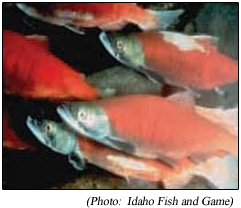Idaho Department of Fish and Game
 The
warm weather may finally be here to stay, and
for many anglers across the state, warm spring
weather means kokanee fishing.
The
warm weather may finally be here to stay, and
for many anglers across the state, warm spring
weather means kokanee fishing.With kokanee fisheries scattered across the state, opportunities abound for anyone to experience these exciting and delicious game fish. Before we talk about catching kokanee, let’s review the basics of kokanee biology.
Kokanee are land-locked sockeye salmon and are found in many lakes and reservoirs across Idaho. Their native range spans from the Columbia River basin to Alaska and includes Idaho. They are also one of the state’s most colorful game fish.
During spring and summer, kokanee have bright silvery sides, blue-green shiny backs and lack spots entirely. In the fall, mature kokanee prepare to spawn and turn bright red with green heads. Males develop a humped back and a long snout with prominent teeth.
Kokanee often migrate into rivers and streams to spawn, but some populations build their nests on gravelly lake shorelines. They prefer cold, clear lakes with water temperatures from 50 to 60 degrees.
They can be found near the surface early in the summer, but they tend to move into deeper waters as temperatures rise. Kokanee feed almost exclusively on zooplankton, which are microscopic invertebrates that drift in the water column. In mid to late summer, kokanee are often found at 30 to 60 feet or more in their search for cold water and the best supply of zooplankton.
Fish and Game stocks kokanee annually in several lakes and reservoirs that do not produce kokanee naturally, or in places where natural spawning may not produce enough fish to sustain sport fishing demands.
Yet managing kokanee fisheries is tricky. Kokanee size and catch rates in each lake must be monitored. If numbers are too low, kokanee size may be great, but catch rates will suffer and fishing will be slow. High kokanee numbers can result in competition for food supplies, meaning kokanee don’t grow well. In this case, average size declines, but catch rates can be high. A balance between too few and too many kokanee is needed to maintain a quality fishery.
Kokanee are typically stocked as 4-inch fingerlings and often grow rapidly. For example, in Lucky Peak Reservoir near Boise, kokanee reach 10 to 13 inches after just one year and 14 to 17 inches after two years, at which point they typically spawn. A small percentage of the population will live a third year and reach 18 to 20 inches.
Near Idaho Falls, kokanee in Ririe Reservoir grow more slowly and typically reach 12 to 14 inches after two years. They often live to three years before spawning.
Kokanee fishing starts to turn on in the weeks approaching spring and continues to be good through mid-summer. Kokanee are caught mainly from boats while slowly trolling lures. Finding the fish often requires a depth finder to locate schooling kokanee. Look for kokanee around large points, across the face of dams and off the mouth of any major spawning tributary.
Typical kokanee lures include a variety of spinners, spoons and soft plastic tube jigs called “hoochies”. Colors vary from reds and pinks, to fluorescent orange and green and others. Visit your local tackle shop for recommendations on the best lures for the water you plan to visit.
Two of the most important aspects of trolling for kokanee are depth and speed. Getting your lure to the depth of the fish is best done with the aid of a downrigger. Don’t worry if you don’t have downriggers. In the spring, kokanee are much shallower, so downriggers are less important early in the season. You can still get your lures down to the fish using colored lead-core trolling lines or varying amounts of rubber-core sinkers in front of your terminal tackle. Adjust the weights for the given trolling speed until you get the right depth. Experiment to get the right speed depending on your lure and line setup – 1.5 mph is a good place to start.
Most folks like to troll their lure with some flashy pop gear or a dodger to attract fish and increase strike potential. Adding some scent or bait to your lure – white shoepeg corn is a favorite – may also increase your odds of hooking a fish. Later in the summer, kokanee form tight schools in preparation for their spawning run, and vertically jigging spoons can be productive if you can locate a big school.
Kokanee are prized for their hard fight and because they make excellent table fare. A fresh kokanee fillet off the grill or from your smoker is a summer highlight. Once you’ve caught your first kokanee, you’ll know why they are so popular with anglers!
To find a place to fish for kokanee near you, go to the Fish and Game website and click the blue Fishing Planner logo. Click on “view recommended waters,” then under the “recommended game fish” section, check the kokanee box. You can filter results to waters in your Region and see maps, recent and historic stocking reports, fishing rules, and the facilities available when you get there.